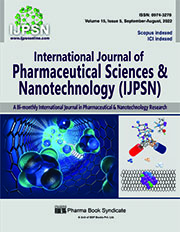Effective use of Silymarin as a promising P-Glycoprotein Inhibitor in the Management of Breast Cancer
DOI:
https://doi.org/10.37285/ijpsn.2022.15.5.6Abstract
Objectives: Chemotherapy has various side effects and toxins, to overcome these problems nanoparticles are formed. Nanoparticles accumulate in tumor cells due to EPR effect. Given the role of P-gp in influencing drug’s pharmacology, methods to overcome P-gp mediated efflux have been investigated. The objectives of present research were to formulate nanoparticles containing DOX and PTX. The present research also includes the potential of flavonoids such as silymarin (SLM) to act as P-gp inhibitors, enabling increased absorption and inhibition of excretion and modulation of multi-drug resistance.
Materials and Methods: Nanoparticles of PLGA and BSA were developed paclitaxel (PTX). Using 23 factorial designs total eight formulations of PTX-PLGA and PTX-BSA nanoparticles were prepared. PLGA (A,) poly vinyl alcohol (PVA) (B) and speed (C) used as independent variants in size of the particles (Y1), efficiency of entrapment (Y2) and % release of drug (Y3) taken as a dependent variable. PTX was successfully applied to the micelles by dissolving.
Results: The median diameter of PTX-BSA and PTX-PLGA nanoparticles ranged from 104 to 1150 nm and 110 to 1023 nm respectively. The effectiveness of the entrapment and release of in vitro drugs also rely on the solubility of the drug and the polymer in the solvent. The use of software is a systematic tool for optimization, and it helps to reduce the cost of experiments.
Conclusion: From the experiments it was concluded that the prepared formulation helped to overcome the multiple drug resistance by incorporation of P-gp inhibitor like silymarin.
Downloads
Metrics
Keywords:
Doxorubicin hydrochloride, paclitaxel, Poly (d, l-lactide-co-glycolide), chitosan, bovine serum albumin, nanoparticlesPublished
How to Cite
Issue
Section
References
Adlin JNJ, Gowthamarajan K, Somashekhara CN. (2009). Formulation and evaluation of nano-particles containing flutamide. Int J ChemTech Res 1(4):1331-34.
Basarkar A, Singh J. (2007). Nano-particulate systems for polynucleotide delivery. Int J Nanomedicine 2(3): 353–60.
Brigger I, Dubernet C, Couvreur P. (2002). Nanoparticles in cancer therapy and diagnosis. Adv Drug Deliv Rev 54(5):631-51.
Cui F, Tao DCA, Yang M, Shi K, Zhao M, Guan Y. (2005). Preparation and characterization of melittin-loaded poly (dl-lactic acid) or poly (dl-lactic-co-glycolic acid) microspheres made by the double emulsion method. J Control Release 107:310-19.
Danhier F, Lecouturier N, Vroman B, Jerome C, Marchand-Brynaert J, Feron O, Preat V. (2009). Paclitaxel-loaded PEGylated PLGA-based nanoparticles: in vitro and in vivo evaluation. J Control Release. 133(1):11-7.
Dong X, Mumper RJ. (2010). Nanomedicinal strategies to treat multidrug-resistant tumors: current progress. Nanomedicine 5(4): 597–615. doi: 10.2217/nnm.10.35.
Goodman LS. and Gilman’s A. (2006). The pharmacological basis of therapeutics. In: Brunton L. L., Lazo J. S., Parker K. L. Editors. 11th ed. Mcgraw-Hill USA,: 1319-21
Harsh Mohan. (2010). Neoplasia. In: Harsh Mohan Editors; Textbook of Pathology, Ed. 6th. Jaypee Brothers, Medical Publishers Pvt. Ltd. New Delhi,:192-225.
Hui L, Changyou G. (2009). Preparation and properties of ionically cross-linked chitosan nanoparticles. Polym Adv Technol 20: 613–19.
Hyuk SY, Keun HL, Jong E Oh, Tae Gwan P. (2000). In vitro and in vivo anti-tumor activities of nanoparticles based on doxorubicin–PLGA conjugates. J Control Release 68:419–31.
Miao H, Min-Jie W. (2012). Reversing multidrug resistance by tyrosine kinase inhibitors. Chin J Cancer. 31(3):126–33. doi: 10.5732/cjc.011.10315.
Mirzajani F, Rafati H, Atyabi F. (2010). Fabrication of biodegradable poly (d,l-lactide-co-glycolide) nanoparticles containing tamoxifen citrate. Iran Polym J 19(6):437-46.
Mohanraj VJ, Chen Y. (2006). Nanoparticle- A Review. Trop J Pharm Res 5(1):561-73.
Rahimnejad MM, Jahanshahi M, Najafpour GD. (2006). Production of biological nanoparticles from bovine serum albumin for drug delivery. Afr J Biotechnol 5(20):1918-1923.
Sadat Tabatabaei Mirakabad F, Nejati-Koshki K, Akbarzadeh A, Yamchi MR, Milani M, Zarghami N, Zeighamian V, Rahimzadeh A, Alimohammadi S, Hanifehpour Y, Joo SW. (2014). PLGA-based nanoparticles as cancer drug delivery systems. Asian Pac J Cancer Prev. 15(2):517-35.
Sailaja AK, Amareshwar P. (2012). Preparation of BSA nanoparticles by desolvation technique using acetone as desolvating agent. Int J Pharm Sci Nanotech 5(1):1643-1647.
Serpe, L. (2007). Conventional Chemotherapeutic Drug Nanoparticles for Cancer Treatment. In: Challa S. S. R. Kumar editor. Nanotechnologies for the life sciences: Nanomaterials for cancer therapy. vol. 6; Wiley-Vch Verlag Gmbh & co. Kgaa, Weinheim:1-30.
Skehan P, Storeng R, Scudiero D, Monks S, McMahon J, Vistica D, Warren JT, Bokesch H, Kenney S, Boyd MR. (1990). New Colorimetric Cytotoxicity Assay for Anticancer-Drug Screening. J. Natl. Cancer Inst. 82(13):1107-1112
Snehalatha M, Kolachina V, Saha RN, Babbar AK, Sharma N, Sharma RK. (2013). Enhanced tumor uptake, biodistribution and pharmaco-kinetics of etoposide loaded nanoparticles in Dalton's lymphoma tumor bearing mice. J Pharm Bioallied Sci; 5(4):290-7. doi: 10.4103/0975-7406.120081
Stolnik S, Daudali B, Arien A, Whetstone J, Heald CR, Garnett MC, Davis SS, Illum L. (2001). The effect of surface coverage and conformation of poly (ethylene oxide) (PEO) chains of poloxamer 407 on the biological fate of model colloidal drug carriers. Biochim Biophys Acta.; 1514(2):261-79.
Sushmitha S, Joydip K, Subhas CK. (2010). Topical review: Biopolymeric nanoparticles. Sci Tech Adv Mater; 11:1-13.
Vichai V, Kirtikara K. (2006). Sulforhodamine B colorimetric assay for cytotoxic screening. Nat Protoc. 1(3):1112-1116.
Zambaux MF, Bonneaux F, Gref R, Maincent P, Dellacherie E, Alonso MJ, Labrude P, Vigneron C. (1998). Influence of experimental parameters on the characteristics of poly (lactic acid) nanoparticles prepared by a double emulsion method. J Controlled Release. 50(1-3):31-40.
Zhang S, Morris ME. (2003). Effects of the flavonoids biochanin A, morin, phloretin, and silymarin on P-glycoprotein-mediated transport. J Pharmacol Exp Ther 304:1258-67.






